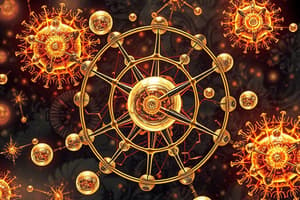Podcast
Questions and Answers
What is the charge of a proton?
What is the charge of a proton?
- +2
- +1 (correct)
- -1
- 0
Which subatomic particle is responsible for the atomic number of an element?
Which subatomic particle is responsible for the atomic number of an element?
- Protons (correct)
- Neutrons
- Positrons
- Electrons
What is the mass of an electron in kilograms?
What is the mass of an electron in kilograms?
- 1.67 x 10^-24 kg
- 9.11 x 10^-31 kg (correct)
- 1.67 x 10^-27 kg
- 9.11 x 10^-30 kg
Which subatomic particle does not contribute to the atomic number of an element?
Which subatomic particle does not contribute to the atomic number of an element?
What is the role of electrons in chemical behavior?
What is the role of electrons in chemical behavior?
Which subatomic particle orbits around the nucleus of an atom?
Which subatomic particle orbits around the nucleus of an atom?
What is the atomic structure of a helium atom?
What is the atomic structure of a helium atom?
What type of bond is formed when two atoms share a pair of electrons?
What type of bond is formed when two atoms share a pair of electrons?
Which type of bond involves a group of atoms sharing a large number of electrons?
Which type of bond involves a group of atoms sharing a large number of electrons?
What determines the strength of the covalent bond between two atoms?
What determines the strength of the covalent bond between two atoms?
How many protons does a carbon atom have in its nucleus?
How many protons does a carbon atom have in its nucleus?
What is the main factor determining the charges of ions in an ionic bond?
What is the main factor determining the charges of ions in an ionic bond?
Flashcards are hidden until you start studying
Study Notes
Atomic Structure in Chemistry
Introduction
Atomic structure is a fundamental concept in chemistry that describes the arrangement of subatomic particles, such as protons, neutrons, and electrons, within an atom. Understanding atomic structure is crucial for explaining the chemical behavior of elements and compounds. In this article, we will delve into the details of atomic structure, focusing on the subatomic particles and their arrangement within an atom.
Subatomic Particles
Protons
Protons are positively charged particles found in the nucleus of an atom. They have a mass of approximately 1.67 x 10^-27 kg and a charge of +1. Protons are responsible for the atomic number of an element, which determines the number of electrons in the element's neutral atom.
Neutrons
Neutrons are neutral particles found in the nucleus of an atom. They have a mass similar to that of protons, approximately 1.67 x 10^-27 kg. Neutrons do not contribute to the atomic number of an element, but they affect the mass number of an isotope.
Electrons
Electrons are negatively charged particles that orbit around the nucleus of an atom. They have a mass of approximately 9.11 x 10^-31 kg and a charge of -1. Electrons are responsible for the chemical behavior of elements and compounds, as they are involved in the formation of chemical bonds and the transfer of electrons in chemical reactions.
Atomic Structure in Different Elements
Hydrogen Atom
A hydrogen atom consists of a single proton in the nucleus, surrounded by a single electron in the first energy level or shell.
Helium Atom
A helium atom has two protons and two neutrons in the nucleus, surrounded by two electrons in the first energy level or shell.
Carbon Atom
A carbon atom has six protons and six neutrons in the nucleus, surrounded by six electrons in the first and second energy levels.
Atomic Structure and Chemical Bonding
The arrangement of electrons in an atom plays a crucial role in determining the chemical behavior of elements and compounds. When two atoms share or exchange electrons, a chemical bond is formed. Different types of chemical bonds, such as covalent, ionic, and metallic bonds, can be explained based on the atomic structure of the elements involved.
Covalent Bond
In a covalent bond, two atoms share a pair of electrons. The atomic structure of the elements involved determines the strength of the bond and the type of covalent bond (e.g., single, double, or triple bond).
Ionic Bond
An ionic bond forms when one atom donates an electron to another atom, creating a positively charged ion and a negatively charged ion. The atomic structure of the elements involved determines the charges of the ions and the strength of the bond.
Metallic Bond
In a metallic bond, a group of atoms share a large number of electrons. The atomic structure of the metal determines the delocalized electron cloud and the strength of the bond.
In conclusion, understanding atomic structure is essential for explaining the chemical behavior of elements and compounds. By studying the arrangement of subatomic particles within an atom, we can predict and model the physical and chemical properties of atoms, which in turn enables us to understand and manipulate the world around us.
Studying That Suits You
Use AI to generate personalized quizzes and flashcards to suit your learning preferences.




